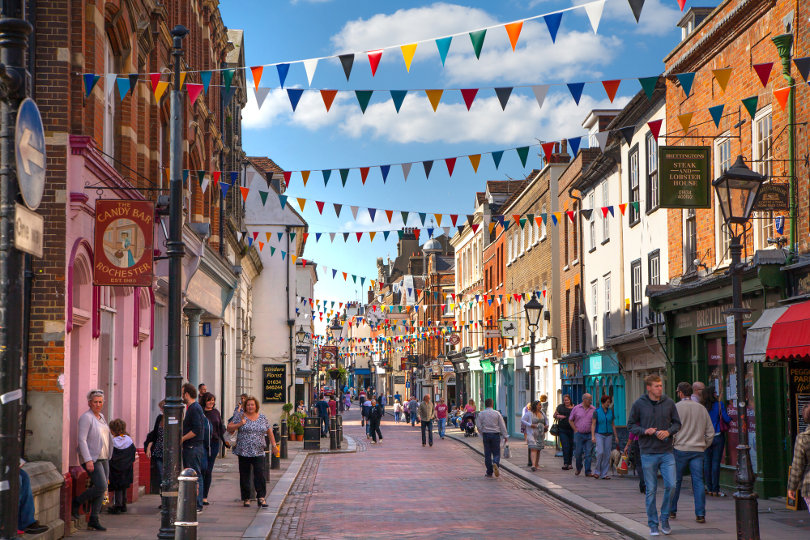Thanks to the internet, the world is now more interconnected than ever before and the modern way of life is getting easier and easier. Just think about it – rather than sending a birthday card the traditional way – picking a card out yourself, writing your message by hand, buying a stamp and posting it yourself – you can now do all that with a few clicks of a button.
Likewise, last-minute presents are now a thing of the past. Thanks to next- and same-day delivery services, you can now purchase goods with literally one click and receive them hours later, meaning you no longer need to stress over a last-minute rush.

The Death of the High Street
While these new functionalities may sound great, the movement of goods and services online has hit the high street hard. The rise of Netflix has killed off Blockbuster, the rise of Spotify killed off HMV temporarily, and the rise of Amazon is currently killing off many other high street businesses – it’s been relentless.
However, while trends have only been heading one way over the years, times are starting to change. Statistics are now starting to show that more and more people are returning high street shops to purchase goods – the fight back appears to be well and truly on.
But is it really? And do independent shops really stand a chance in today’s world? Let’s take a look at the facts.
Stat Attack
According to recent findings, it turns out that yes – independent high street shops are indeed fighting back.
In May earlier this year, research by Visa found that more than 34,500 independent shops had opened in the past year – a 4.5% increase from 2017. This came despite a huge increase in costs and a surge in competition from several online giants.
Shoppers were found to agree with the statistics as well, with 34% saying that they preferred high street shopping to online, and 60% still visiting their local high street at least once a week.
Unfortunately, the news wasn’t all positive though, as the number of openings remain hugely outnumbered by the number of closures. However, Visa’s findings are encouraging, and prove that the high street isn’t done quite yet.

Click & Collect
One of the reasons behind this resurgence has been potentially due to the movement of independent shops online. Because of this transition, independent shops can now offer click and collect services to their customers – a convenient option which bypasses the increasing delivery difficulties customers encounter with some of the larger online retailers.
Having an effective online presence can also make a big difference to who can actually see and interact with your business. For instance, having a website which showcases your goods and services will allow you to attract shoppers from further afield, potentially even removing the need to pay the high costs of renting a physical city-centre shop.
This proved to be the case for Sara Strafford – a Sunderland-based fashion retail business owner. In an article published by Business Advice, she said: “There was a time when being visible on the high street would have been essential to running my business. But, [in the end], I had to close my city-centre business because [the] rent was too high.
“Now I’ve moved the majority of my sales online and taken space in a BizSpace centre, it’s given me flexibility and support, enabling me to dedicate more time to running my business rather than managing my finances.”
Should Not Have Gone To Specsavers
Other independent shops have come up with similarly innovative ways to fight back against the tide. From a gift voucher specifically designed to be used at independent shops, to a website dedicated to selling produce from a wide range of independent shops, the rise of Amazon and other online giants has seen independent shops join together to entice customers.
Take optometrist Conor Heaney, for example. Despite competition from large high-street optometrists Specsavers and Vision Express, he has managed to keep his optometry business more than afloat – nearly tripling his revenue over the past decade.
In a statement, he said: “Since 2009, I have grown my practice from £400,000 revenue to £1.1 million, while cutting my working hours down to just one day a week – so I am proof that being a successful independent retailer is doable.”
Refining his approach, Heaney invested over £80,000 educating himself in business and marketing to learn innovative methods that would help his optometry practice. He now passes on what he’s learnt to fellow independent optometrists via his Optical Success Academy, helping them to be successful as well.
“I don’t think being an independent retailer is all as doom and gloom as it’s made out to be,” he continued, “I’ve seen optometrists grow first-hand, increasing their average eyewear sales by margins you wouldn’t think possible – it’s fantastic to see.”

Conclusion
Maybe Mr Heaney is right. The resurgence of independent shops certainly seems to be in full effect, and evidence now suggests that high street shops still have a major role to play in how we buy goods and services.
While the majority of these purchases will take place online, that doesn’t mean you, as a consumer, have to use one of the huge online conglomerates. With the world becoming more and more technological, independent shops are becoming better at utilising their presence online, standing out from the crowd and offering prices as low as other retailers.
Therefore, it’s safe to say that the fight back is most definitely on.







